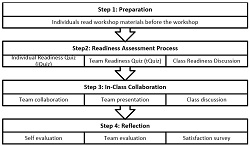Faculty practices that foster student persistence
While scouring attrition literature can provide ideas for advancing student persistence, Sarah Curtis pointed out that "the most valuable research for an institution will be the research conducted on that institution's own population" (2005, 17). Combining Curtis' counsel with an understanding of the vital connection between faculty and student commitment (Bean, 2005), I conducted focus group research with the faculty of two adult higher education institutions to identify faculty practices that can best support adult students to achieve academic goals in higher education. Following is a summary of key practices adult faculty recommended for supporting student persistence in an adult higher-education environment (Duncan, 2007):
- Affirm. Continuously affirm each student's decision to attend the University by helping students remember or realize why they are in school, and continuously communicate the value of pursuing higher education.
- Integrate. Help students reduce the juggling act between personal, professional, and academic life compartments by encouraging them to create opportunities for integrating projects, processes, and perspectives for more effective professional development--inside and outside the classroom. The most successful student is the one who leverages course work for career advancement while in the pursuit of a diploma.
- Model. Model the correct behaviors that advance academic, personal, and professional growth.
- Coach. Coach students with the skills they need to drive themselves and other students to succeed on their own and in their learning community.
- Orient. Accelerate and foster student orientation into the culture and processes of the university and the classroom. Provide students with the tools, capacity, and resilience necessary to excel in a demanding and fast-paced professional development program.
- Engage. Take a personal interest in the academic and professional development of each student, actively engaging in mutual development.
- Communicate. Communicate with each student before, during, and after each class. Create communication opportunities that foster student growth, including delivering significant and timely feedback, praising accomplishments, celebrating milestones, and helping students socialize and adapt in a dynamic environment.
- Connect. Create opportunities to connect regularly with each student on a personal level. Contact students who miss a workshop to let them know they were missed and to keep them on track for meeting course objectives.
- Recognize. Create opportunities to recognize and celebrate outstanding scholarship, professional accomplishments, and personal milestones.
- Anticipate. Recognize when students are struggling with individual, team or university issues that might adversely affect performance, satisfaction, and commitment. Take proactive steps to help each individual student fully engage in the benefits the course offers.
- Intervene. Look for opportunities to develop the scholarly skills and commitments of students. Know how to provide or recommend available support services for students who seem to be struggling with academic competencies or course objectives.
- Develop. Provide consistent, timely, and constructive feedback that develops growth and motivation.
- Relate. Help students recognize how course material and classroom activities make them more effective in their personal, professional, and academic lives.
- Socialize. Create a classroom environment that actively recognizes the individual value of each student, and that engages students in developing one another.
- Value. Make sure students leave each workshop with valuable knowledge and skills that they can immediately apply for more effective personal and professional lives. Promote the unique value the institution and class provide for the student. Contribute unique value to the institutional learning model. Help students recognize the growing value they provide for themselves, their families, their learning teams, and their employers.
Institutional practices for supporting student success
To help develop programs that actively foster student persistence, adult higher education institutions can do the following:
Develop a holistic-system perspective of student success
A holistic system perspective of student success can help the institution anticipate and address potential attrition issues prior to enrollment. For example, the typical messaging for open enrollment online programs focus on how easy and convenient online learning can be. While this message might be a reality for a diploma mill, a credible accredited program can require a different skill-set than students are used to in a traditional classroom, including an ability to learn in isolation, be self-directed in learning, and manage time effectively to learn.
Understanding that student preparation is a key predictor of student success, marketing and enrollment can engage in helping students recognize the disconnect between where they want to be and showing them how the institution will work with them to set goals to take action that closes the gap.
Isolate the limitations a student brings to the classroom and remediate
More than anything the University can do, one of the most accurate predictors of student success is student preparation. This is why traditional institutions establish high acceptance standards with resulting high retention rates. Accepting students who have already proven successful in life helps assure high retention rates.
Institutions that open doors to underserved populations are essential for providing opportunities to those who cannot overcome barriers to traditional institutions. But, this does not become an excuse for boosting enrollment by pushing into the classroom students who lack the capacity and competency to succeed. Such practices are equivalent to recruiting high school students into the military and sending them directly to the front lines of combat. A few may survive, most will not.
This makes remediation programs essential for serving the developmental needs and fostering the success competencies of students in open-enrollment institutions. Identifying the limitations a student brings to the classroom helps inform the remediation programs the University should implement to prepare the student for success in higher education. At least, students in open-enrollment institutions deserve a "boot camp" that prepares them to thrive despite the challenges of higher education.
Coordinate key student touchpoints
By coordinating student contact points among faculty and counselors, institutions can align front-line resources to identify and address at-risk behaviors. Such a connection can be established with an early alert process through which faculty can engage counselors to support interventions. In online environments, faculty and counselors can use shared analytics dashboards to monitor student engagement and performance, and independently initiate interventions based on shared data.
Develop a robust primary attrition research program
A comprehensive primary research program can help an institution identify sources of problems that may contribute to attrition, and isolate attrition causes over which the University has control. A comprehensive primary research program can include drop surveys, continuance surveys, and completion surveys.
Drop surveys.
Understanding that the withdrawal rate is more of a symptom than a problem can help an institution avoid retention myopia that leads to diplomas without value and students without education. Basing retention initiatives on a tally of withdrawals can mean the institution is allocating resources to solve problems beyond its reach while allowing the problems to fester. To understand what the college might do to correct internal problems that might contribute to student attrition, an institution can implement drop surveys to isolate the cause of withdrawals as they happen (Stover, 2005).
Continuance surveys.
Dropout research and interventions are reactive actions that are often too late to prevent attrition. Dropout research "can be an inefficient use of resources" (Stover, 2005, 1). Bailey and Alfonso (2005) determined that more proactive approaches may improve student persistence and performance. Examples of proactive approaches to mitigate attrition risk include screening, remediation programs, early intervention with counseling, and support services. To anticipate and proactively mitigate attrition, the institution may consider developing a process for measuring student motivation, satisfaction, self-efficacy, and commitment to graduate. Continuance surveys can help retention teams take proactive steps to support student persistence, and allow more timely and effective interventions with struggling or dissatisfied students.
Completion surveys.
Understanding the internal and external factors that supported a student through graduation can help the college to develop processes and programs that leverage organizational and customer strengths for mutual benefit. Conducting surveys on successful graduates will help the college "differentiate students who stay from students who leave" (Habley & McClanahan, 22). Isolating the characteristics and behaviors of successful students can inform orientation, training, and reinforcement programs for helping other students develop success competencies.




